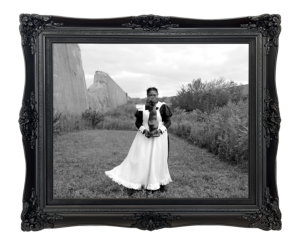Performative activations from current exhibiting artists R. Treshawn Williamson & Lola Ayisha Ogbara, with special guest artist Jada-Amina.
Borrowed from Lola Ayisha Ogbara’s video work ‘Bound For Glory’ from her continuing series The Perfect Servant, THE GESTURE ITSELF IS PROTECTION SPELL proposes questions of the body, disruption, labor, acts of looking, and materiality through movement, sound, and mythmaking.
Williamson, Ogbara, and Amina engage in multidisciplinary practices that reference homeplace, memory, and the “gaze” that take place across photography, video, sculpture, sound, and printmaking.
THE GESTURE ITSELF IS PROTECTION SPELL will feature a collaborative live sound activation by R. Treshawn Williamson and Jada-Amina followed by Lola Ayisha Ogbara’s video work ‘Bound For Glory’, in which Ogbara uses Chicago’s labor intensive history, centralizing Black women domestic workers, to envision a radical future for Black lives. Ogbara finds an additional dialogue between sculpture and experimental photography that challenges our relationship to viewership. Ogbara questions, “What lengths are we willing to go to in order to protect what is rightfully ours?” as she begins to imagine a collective disruption in the way we use our bodies to perform artistic labor.
In the same ways Ogbara imagines collective disruption and Black women’s labor , R. Treshawn Williamson and Jada-Amina also explore the Black maternal and cultural re-imagination through sound mixing and oral histories, through what Amina describes as “a sonic meditation grounded in incantation and afro-sentimentality…”

Image courtesy of Lola Ayisha Ogbara. Bound For Glory. 4 minutes 36 seconds. 2021
This program is the final program related to our current exhibition “…of the land: acts of refusal and ratification” , which features new and recent works from Chicago-based artists Ajmal ‘Mas Man’ Millar, Lola Ayisha Ogbara, and R. Treshawn Williamson exploring sculpture, self-imaging and history through postcolonial lenses, collective & individual recollection and peculiar materialism.



